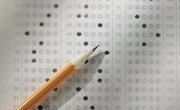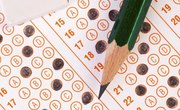The Developmental Reading Assessment is a criterion-referenced assessment, meaning that it compares a student’s performance to a set of established standards, rather than to the performance of other examinees. Loosely based on the Informal Reading Inventory, the test uses a series of books at increasingly difficult reading levels to check kindergarten through eighth-grade students’ knowledge of phonics concepts, reading accuracy, and fluency and comprehension on Levels A-80. Teachers administer the exam at the beginning of the year to establish a benchmark, or starting level. After that, some schools administer the test during each grading period, while others use it only at the end of the academic year. Each school or district sets the specific grade level expectations, but parents can use a rule of thumb to interpret the scores.
Step 1
Establish your child’s benchmark score by consulting with the classroom teacher who administered the test.
Step 2
Review the grade-level standards specific to your child’s school or use the general scale for each grade level. Kindergarten teachers usually expect their students to master levels A-4, first-graders to test at levels 6-18, second-graders at 18-28, third-graders at 20-28, and fourth- and fifth-graders at 40-50.
Step 3
Divide the score range by the number of testing periods to get a rough estimate of where your child should score at different points during the school year. For example, if your child is in the first grade and takes the test four times during the year, subtract 6 from 18 and divide that result, 12, by 4 to obtain 3. For an on-level rating, she should need a score of 6 to 9 on the initial test, 10 to 12 on the second, 13-15 on the third and 16 or higher on the last.
Related Articles
References
Writer Bio
Pamela Martin has been writing since 1979. She has written newsletter articles and curricula-related materials. She also writes about teaching and crafts. Martin was an American Society of Newspaper Editors High School Journalism Fellow. She holds a Bachelor of Arts in Teaching in elementary education from Sam Houston State University and a Master of Arts in curriculum/instruction from the University of Missouri.











